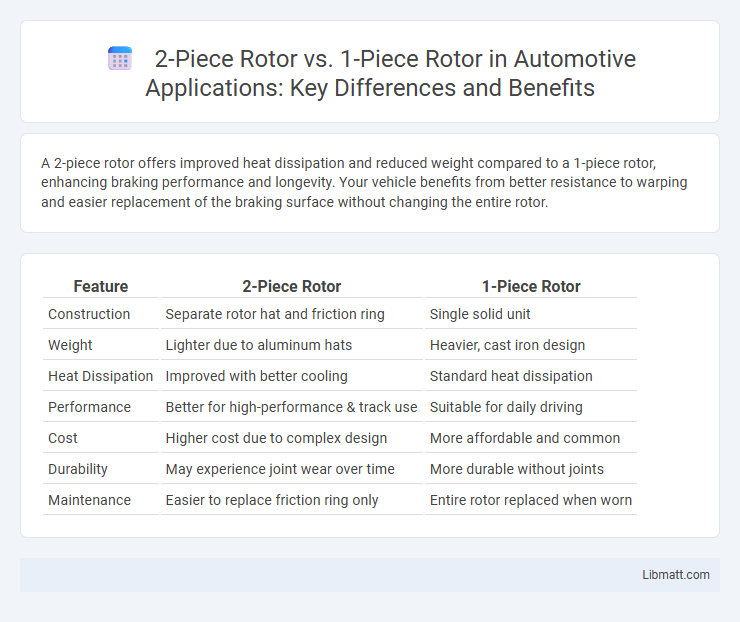A 2-piece rotor offers improved heat dissipation and reduced weight compared to a 1-piece rotor, enhancing braking performance and longevity. Your vehicle benefits from better resistance to warping and easier replacement of the braking surface without changing the entire rotor.
Table of Comparison
| Feature | 2-Piece Rotor | 1-Piece Rotor |
|---|---|---|
| Construction | Separate rotor hat and friction ring | Single solid unit |
| Weight | Lighter due to aluminum hats | Heavier, cast iron design |
| Heat Dissipation | Improved with better cooling | Standard heat dissipation |
| Performance | Better for high-performance & track use | Suitable for daily driving |
| Cost | Higher cost due to complex design | More affordable and common |
| Durability | May experience joint wear over time | More durable without joints |
| Maintenance | Easier to replace friction ring only | Entire rotor replaced when worn |
Introduction to Brake Rotors: 2-Piece vs 1-Piece
Brake rotors are essential components in vehicle braking systems, with 1-piece rotors featuring a single solid design made entirely from cast iron or similar materials, offering simplicity and cost-effectiveness. In contrast, 2-piece rotors consist of a separate rotor ring and hub, often made from lighter alloys combined with a cast iron braking surface, enhancing heat dissipation and reducing unsprung weight for improved performance. This design distinction affects durability, cooling efficiency, and maintenance flexibility in automotive braking applications.
Construction Differences: 2-Piece and 1-Piece Rotors
Two-piece rotors feature a separate, often aluminum, hat and a cast iron braking surface, allowing improved heat dissipation and reduced unsprung weight compared to one-piece rotors made entirely of cast iron. The modular construction of two-piece rotors enables easier replacement of worn braking surfaces without discarding the entire rotor, enhancing cost efficiency. In contrast, one-piece rotors are simpler in design but heavier and less effective at managing thermal expansion during high-performance braking conditions.
Performance Comparison: Heat Dissipation
Two-piece rotors offer superior heat dissipation compared to one-piece rotors due to their design, which typically includes an aluminum hat connected to a cast iron braking surface, allowing better heat expansion and cooling. The aluminum center conducts heat away more efficiently, reducing brake fade under high-performance conditions or prolonged use. This enhanced thermal management improves braking reliability and extends rotor lifespan relative to one-piece rotors.
Weight Considerations: Unsprung Mass Impact
Two-piece rotors significantly reduce unsprung mass compared to one-piece rotors by separating the lightweight aluminum hat from the cast iron braking surface. This reduction in unsprung mass improves suspension responsiveness and enhances overall vehicle handling characteristics. Lower unsprung weight also contributes to increased ride comfort and better tire contact with the road, optimizing braking performance and stability.
Durability and Longevity: Which Lasts Longer?
A 2-piece rotor typically offers superior durability and longevity compared to a 1-piece rotor due to its design, which allows for better heat dissipation and reduced warping under high stress. The separate rotor and hat components in 2-piece rotors can be replaced independently, extending overall lifespan and maintaining optimal performance. If you prioritize long-lasting brake components, investing in a 2-piece rotor is often a smarter choice.
Maintenance and Replacement Costs
Two-piece rotors offer easier and more cost-effective maintenance because only the worn-out surface needs replacement rather than the entire rotor, significantly reducing parts and labor expenses. One-piece rotors often require full replacement even for minor surface wear, leading to higher maintenance costs over time. Your repair bills can be lowered by choosing two-piece rotors, especially in performance or heavy-duty vehicles where frequent brake servicing is necessary.
Compatibility with Vehicles and Upgrades
Two-piece rotors offer enhanced compatibility with high-performance and heavy-duty vehicles due to their modular design, allowing separate replacement of the rotor ring and hub, which suits upgraded braking systems. One-piece rotors are commonly compatible with standard passenger vehicles, providing straightforward installation but limited flexibility for customization or performance enhancements. Upgrading to two-piece rotors is often preferred for improved heat dissipation and reduced weight, benefiting vehicles requiring superior braking efficiency and durability.
Noise, Vibration, and Comfort Differences
Two-piece rotors significantly reduce noise and vibration compared to one-piece rotors due to their separate rotor ring and hub design, which minimizes thermal distortion and allows better heat dissipation. This design enhances driving comfort by providing smoother braking performance and reducing brake judder. One-piece rotors, while simpler and less expensive, are more susceptible to heat buildup and warping, resulting in increased noise and vibration.
Ideal Applications: Street vs Track Use
Two-piece rotors excel in track use due to their enhanced heat dissipation and reduced warping under intense braking conditions, making them ideal for high-performance and competitive environments. One-piece rotors are better suited for street applications, offering simplicity, lower cost, and adequate performance for everyday driving. Your choice should align with your driving demands, favoring two-piece rotors for track reliability and one-piece rotors for daily street use.
Choosing the Right Rotor for Your Needs
Choosing between a 2-piece rotor and a 1-piece rotor depends on factors like cost, performance, and durability requirements. A 2-piece rotor offers improved heat dissipation and reduced warping due to its aluminum hat and steel braking surface, making it ideal for high-performance or heavy-duty applications. In contrast, a 1-piece rotor is more cost-effective and simpler to replace, suitable for everyday driving and standard braking needs.
2-piece rotor vs 1-piece rotor Infographic

 libmatt.com
libmatt.com